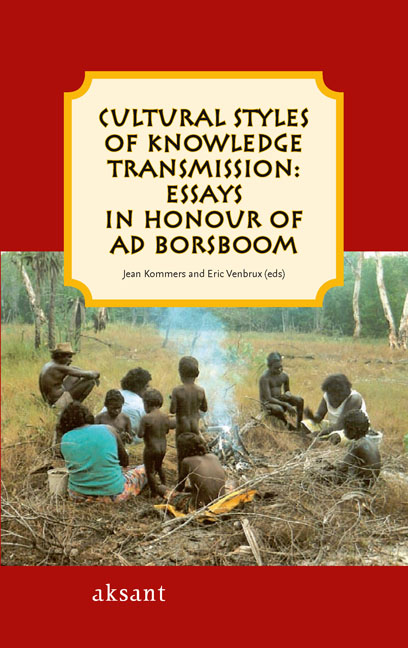Book contents
- Frontmatter
- Introduction
- Ad Borsboom
- Contents
- Maradjiri and Mamurrng: Ad Borsboom and Me
- Conversations with Mostapha: Learning about Islamic Law in a Bookshop in Rabat
- Education in Eighteenth Century Polynesia
- From Knowledge to Consciousness: Teachers, Teachings, and the Transmission of Healing
- When ‘Natives’ Use What Anthropologists Wrote: The Case of Dutch Rif Berbers
- The Experience of the Elders: Learning Ethnographic Fieldwork in the Netherlands
- On Hermeneutics, Ad’s Antennas and the Wholly Other
- Bontius in Batavia: Early Steps in Intercultural Communication
- Ceremonies of Learning and Status in Jordan
- Al Amien: A Modern Variant of an Age-Old Educational Institution
- Yolngu and Anthropological Learning Styles in Ritual Contexts
- Learning to Be White in Guadeloupe
- Learning from ‘the Other’, Writing about ‘the Other’
- Maori Styles of Teaching and Learning
- Tutorials as Integration into a Study Environment
- The Transmission of Kinship Knowledge
- Fieldwork in Manus, Papua New Guinea: On Change, Exchange and Anthropological Knowledge
- Bodily Learning: The Case of Pilgrimage by Foot to Santiago de Compostela
- Just Humming: The Consequence of the Decline of Learning Contexts among the Warlpiri
- A Note on Observation
- Fragments of Transmission of Kamoro Culture (South-West Coast, West Papua), Culled from Fieldnotes, 1952-1954
- Getting Answers May Take Some Time… The Kugaaruk (Pelly Bay) Workshop on the Transfer of Inuit Qaujimajatuqangit from Elders to Youths, June 20 - 27, 2004
- Conflict in the Classroom: Values and Educational Success
- The Teachings of Tokunupei
- Consulting the Old Lady
- A Chain of Transitional Rites: Teachings beyond Boundaries
- ‘That Tour Guide – Im Gotta Know Everything’: Tourism as a Stage for Teaching ‘Culture’ in Aboriginal Australia
- The Old Fashioned Funeral: Transmission of Cultural Knowledge
A Note on Observation
- Frontmatter
- Introduction
- Ad Borsboom
- Contents
- Maradjiri and Mamurrng: Ad Borsboom and Me
- Conversations with Mostapha: Learning about Islamic Law in a Bookshop in Rabat
- Education in Eighteenth Century Polynesia
- From Knowledge to Consciousness: Teachers, Teachings, and the Transmission of Healing
- When ‘Natives’ Use What Anthropologists Wrote: The Case of Dutch Rif Berbers
- The Experience of the Elders: Learning Ethnographic Fieldwork in the Netherlands
- On Hermeneutics, Ad’s Antennas and the Wholly Other
- Bontius in Batavia: Early Steps in Intercultural Communication
- Ceremonies of Learning and Status in Jordan
- Al Amien: A Modern Variant of an Age-Old Educational Institution
- Yolngu and Anthropological Learning Styles in Ritual Contexts
- Learning to Be White in Guadeloupe
- Learning from ‘the Other’, Writing about ‘the Other’
- Maori Styles of Teaching and Learning
- Tutorials as Integration into a Study Environment
- The Transmission of Kinship Knowledge
- Fieldwork in Manus, Papua New Guinea: On Change, Exchange and Anthropological Knowledge
- Bodily Learning: The Case of Pilgrimage by Foot to Santiago de Compostela
- Just Humming: The Consequence of the Decline of Learning Contexts among the Warlpiri
- A Note on Observation
- Fragments of Transmission of Kamoro Culture (South-West Coast, West Papua), Culled from Fieldnotes, 1952-1954
- Getting Answers May Take Some Time… The Kugaaruk (Pelly Bay) Workshop on the Transfer of Inuit Qaujimajatuqangit from Elders to Youths, June 20 - 27, 2004
- Conflict in the Classroom: Values and Educational Success
- The Teachings of Tokunupei
- Consulting the Old Lady
- A Chain of Transitional Rites: Teachings beyond Boundaries
- ‘That Tour Guide – Im Gotta Know Everything’: Tourism as a Stage for Teaching ‘Culture’ in Aboriginal Australia
- The Old Fashioned Funeral: Transmission of Cultural Knowledge
Summary
In his major book, The Wild Honey Clan, Ad Borsboom discusses several strategies that Australian Aborigines employ to transmit knowledge, without making use of written messages. He mentions the use of a variety of metaphors, and the imagining of such metaphors in stories and dances, that are, moreover, regularly told and performed (2006: 101f ). In this brief note I shift the focus to the role of observation, in part because during my research among the Western Dani, I did not acquire the linguistic facility to record long stories, in part because I focus on other types of knowledge, and, maybe, in part because of different cultural orientations among the peoples concerned.
In 1960, while preparing for my field work among the Western Dani, I presumed that I would learn a great deal about their way of life by observing how young Dani were taught skills by their elders. This presumption did not come true at all. Shortly after my arrival among the Wanggulam, the group of Dani among whom I had decided to work, they started preparing a new set of food gardens. Much of the work was done by parties of men helping each other on a reciprocal basis. Although they worked together in the same locality and on the same job, for instance cutting trees and removing undergrowth, they did so independently, by themselves.
That appeared most strikingly during fence building. Dani fences, serving to keep pigs out of food gardens, are sturdy structures. They consist of roughly adzed, irregularly shaped planks, put horizontally on top of each other, and held in place by vertical poles on either side of the planks. They were tied together with rattan. On top short poles are put crosswise and the structure is topped off by a mixture of grasses, vines and other small plants to protect it against the heavy rains. Each man built a separate section of the fence, about three meters long. Having finished that section, he might start building another, a bit further on. Never did I see a young man helping another man so as to learn on the job. They all seemed to be knowledgeable fence builders.
Information
- Type
- Chapter
- Information
- Cultural Styles of Knowledge TransmissionEssays in Honour of Ad Borsboom, pp. 119 - 122Publisher: Amsterdam University PressPrint publication year: 2009
